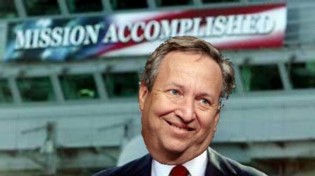 |
When the people lose faith, they do not then believe in nothing. They believe in anything.
For a change of pace, today we present our two-part analysis as an interview of yours truly by an old friend of iTulip who has reported for several major news publications for more than 20 years. Our interviewer goes by the initials ND. If readers like the format, we’ll do it again.
ND: Do you miss the old Hunter Thompson as much as I do?
EJ: Last week I listened to a recording of a lecture he gave at Boulder University in 1977 after he published Fear and Loathing in Las Vegas. At one point a student in the audience asks if there is anything that he as a young person heading out into the world can do to help get the U.S. off the self-destructive course that Thompson describes in his book. Thompson is fatalistic. He says, no, there is not, that the crazed system is destined to go on and on until it blows itself up and burns itself out. Looks like he was right.
ND: We blew it. The media, I mean.
EJ: We use this catch phrase at iTulip: “Who could have known?” to refer to any obvious outcome of excess and fraud over the past 11 years that we've been in operation. Anyone reading our site—and plenty of others—since 1998 could see the current crisis coming down hard on us, but not if they only read mainstream papers or watched cable or network TV. After a string of failures to protect the public from cheats, crooks, and liars—the primary role of the media—a cloud of suspicion hangs over the whole industry. On top of the business model challenges created by the Internet, there’s a real crisis of credibility. Today they’re backpedaling as hard and fast as they can, and maybe readers will forget that the media hung them upside down to have their pockets picked by mortgage brokers and stock jobbers selling the American dream as a debt they can’t repay and a stock portfolio that vaporizes as soon as they reach retirement age. It's a safe bet they will forget.
ND: Who’s doing a good job today?
EJ: The Wall Street Journal is doing a good job of covering the crisis now that it’s here. Plenty of thoughtful skepticism about the recovery. But the fact remains that the savings of a generation of our middle class was wiped out by the stock and housing bubbles. Failure by the media to expose the frauds while they were being perpetrated has caused millions to lose faith in the mainstream media.
ND: Who will take its place? Glenn Beck and Alex Jones?
EJ: The average American doesn’t know how to be intelligently skeptical. They lack the tools. Their schooling taught them to believe what they read in the paper and watch on TV and are told by anyone in a uniform or anyone who makes more money than they do. For example, the mortgage broker in a suit who told them not to worry about exaggerating income in order to qualify for a ridiculously huge mortgage. You can say these people were stupid for trusting the brokers and the appraisers and the lawyers and all of the other conspirators to the gigantic fraud that came to be known as the housing bubble, including the media that used to quote the National Association of Realtors as a source of information about the safety of housing as an investment. That’s journalism? But who is the public supposed to trust? No one? So now the public doesn’t trust anyone. Why should they? But in the wake of these frauds they lack the tools necessary for critical evaluation of even the most basic data about their economy, never mind complicated issues like monetary policy, inflation, and employment. In this environment guys like Glenn Beck and Alex Jones thrive.
ND: Where is this headed?
EJ: When the people lose faith, they do not then believe in nothing. They believe in anything. Between an oligarchic government controlled media and a public unable to distinguish between an argument made on evidence and one based on speculation, I believe we are heading into an era of rising nationalism and unreason unlike anything we have seen since the 1930s. The antecedents are exceedingly dangerous. Our polity can be whipped up into a frenzy to do just about anything.
ND: Where is the leading edge of rising nationalism?
EJ: Japan just elected the first government since the end of WWII that represents a break from alignment with the U.S. The election was a big deal in Asia. The winning platform was distance from Washington and separation from Wall Street.
ND: Japan was hit especially hard by the global recession that we caused.
EJ: True, but it’s important to remember that our economic relationship with Japan has been difficult since at least the Kennedy administration.
For U.S trade partners like Japan, the U.S. has been like a very large and important customer that delivers most of the revenue to a goods manufacturer. Endlessly demanding, at times irrational and occasionally dangerous, our behavior was tolerated for one and only one reason: we, the customer, always placed our order by the end of the quarter. All was forgiven.
Then the 2008 crisis came. We, as a major customer to our global trade partners, have always been difficult to do business with, but at least we were worth it for the orders, even if they had to provide much of the financing. But since U.S. consumer demand for imports fell off a cliff last year, we’re not worth the trouble.
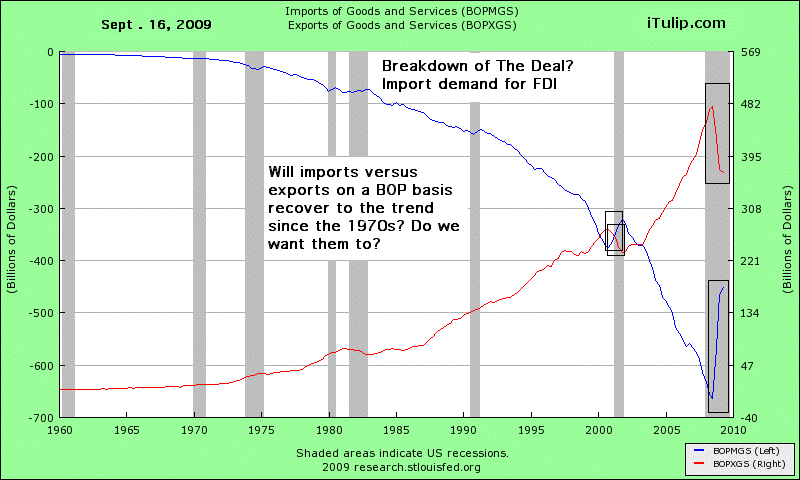
Yet our demanding and irrational behavior continues as if we were still the world’s most important customer or we will regain that status shortly, if only we print and borrow enough money to get households borrowing and buying again. The perpetuation of this delusion will end in tears.
ND: What did we do to Japan under the Kennedy administration? I don't remember that.
EJ: In my research I came across a reference on Sony Corporation’s web site that stated that Japan's 1965 economic depression was rooted in the interest equalization tax instituted two years earlier by President John F. Kennedy. The U.S. economy was in recession and domestic capital was pouring out of the country. Kennedy imposed a 16.5% interest equalization tax on all capital leaving the U.S. to slow the outflow--basically, a capital control. The law succeeded in decreasing the outflow of U.S. capital but it also caused a panic in world stock markets. In 1965, Japan’s securities market crashed and Japan had its worst depression since The Great Depression.
While it’s tempting to see events like the election of an anti-U.S. government in Japan as a recent development, the issues between the two countries that led to that outcome have been brewing for decades. The 1980s bubble and crash was also a product of U.S. policy. Political change, such as shown in the election of a new government in Japan, appears sudden if you haven’t followed the history and antecedents.
After this latest U.S. financial and economic debacle that cratered Japan’s economy, the Japanese people decided they’ve had enough.
ND: Who’s next?
EJ: Hard to say but my contacts tell me nationalism is rising in China in parallel with the decline of the Chinese economy. There are over 20 million officially unemployed and another 20 to 30 unofficially. There is a good video on the front of the site on the current unemployment crisis in China. Nationalism is a powerful tool of government to use to externalize blame for domestic governance mistakes. The CCP has used it in the past and there is no reason to think they will not use it again.
But the political shift away from the U.S. motivated by the global crash is not confined to Asia. I strongly recommend reading the August 24, 2009 letter Farewell America by Swiss investment bank Wegelin & Co. The letter reveals how much of Europe sees us as well, and will express if they calculate that the costs of a future business relationship outweigh the benefits. Here's an excerpt:
ND: What did we do to Japan under the Kennedy administration? I don't remember that.
EJ: In my research I came across a reference on Sony Corporation’s web site that stated that Japan's 1965 economic depression was rooted in the interest equalization tax instituted two years earlier by President John F. Kennedy. The U.S. economy was in recession and domestic capital was pouring out of the country. Kennedy imposed a 16.5% interest equalization tax on all capital leaving the U.S. to slow the outflow--basically, a capital control. The law succeeded in decreasing the outflow of U.S. capital but it also caused a panic in world stock markets. In 1965, Japan’s securities market crashed and Japan had its worst depression since The Great Depression.
While it’s tempting to see events like the election of an anti-U.S. government in Japan as a recent development, the issues between the two countries that led to that outcome have been brewing for decades. The 1980s bubble and crash was also a product of U.S. policy. Political change, such as shown in the election of a new government in Japan, appears sudden if you haven’t followed the history and antecedents.
After this latest U.S. financial and economic debacle that cratered Japan’s economy, the Japanese people decided they’ve had enough.
ND: Who’s next?
EJ: Hard to say but my contacts tell me nationalism is rising in China in parallel with the decline of the Chinese economy. There are over 20 million officially unemployed and another 20 to 30 unofficially. There is a good video on the front of the site on the current unemployment crisis in China. Nationalism is a powerful tool of government to use to externalize blame for domestic governance mistakes. The CCP has used it in the past and there is no reason to think they will not use it again.
But the political shift away from the U.S. motivated by the global crash is not confined to Asia. I strongly recommend reading the August 24, 2009 letter Farewell America by Swiss investment bank Wegelin & Co. The letter reveals how much of Europe sees us as well, and will express if they calculate that the costs of a future business relationship outweigh the benefits. Here's an excerpt:
At the risk of once again winding up certain specialists in business ethics, let us briefly recall the sort of tax authorities we are dealing with, and the sort of state they serve: a country that, over the last 60 years, has unquestionably been one of the most aggressive nations in the world. The USA has fought by far the largest number of wars, sometimes with, but mostly without a UN mandate. It has broken the international laws of war, maintained secret prisons, and fought an absurd war against drugs, with serious consequences both abroad (Columbia, Afghanistan) and at home (according to reliable sources, the tentacles of the narcotics mafia now reach well into political circles).
With breathtaking moral duplicity, the USA maintains enormous offshore havens in Florida, Delaware and others of its states. The moralizers have joined sides with a nation that still makes extensive use of the death penalty, and that has a legal system under which lawyers can get rich on the misfortunes of their clients. Liability cases often end in verdicts with exorbitant damages, which makes business activity extremely risky, for medium-sized enterprises in particular. The moralizers provide intellectual support for a country that allows its infrastructure to collapse, and then stuffs convicts into hopelessly overfilled jails, after what are not infrequently dubious proceedings. They fund a nation that tolerates – or rather, causes – regular crises in the global financial system that it manages.
A country whose underclass enjoys neither the benefits of an adequate education, nor a halfway functional healthcare system; a country whose economic system is increasingly inclined to over-consumption, and in which saving and investing have increasingly become alien concepts, a situation that has undoubtedly been one of the driving forces behind the current recession, with all its catastrophic consequences for the whole world.
Read it if you want to know how a former "supplier" to USA, Inc.--in this case of specialized banking services--thinks of us but was not willing to say to our face before they gave up on us as a future customer. We've been written off. Think about it. We post the letter as a resource at the end of Part II. With breathtaking moral duplicity, the USA maintains enormous offshore havens in Florida, Delaware and others of its states. The moralizers have joined sides with a nation that still makes extensive use of the death penalty, and that has a legal system under which lawyers can get rich on the misfortunes of their clients. Liability cases often end in verdicts with exorbitant damages, which makes business activity extremely risky, for medium-sized enterprises in particular. The moralizers provide intellectual support for a country that allows its infrastructure to collapse, and then stuffs convicts into hopelessly overfilled jails, after what are not infrequently dubious proceedings. They fund a nation that tolerates – or rather, causes – regular crises in the global financial system that it manages.
A country whose underclass enjoys neither the benefits of an adequate education, nor a halfway functional healthcare system; a country whose economic system is increasingly inclined to over-consumption, and in which saving and investing have increasingly become alien concepts, a situation that has undoubtedly been one of the driving forces behind the current recession, with all its catastrophic consequences for the whole world.
[media]http://www.itulip.com/video/shockedgambling.mp4[/media]
Keep in mind that next year is an unusually active election year world wide, with more than 60 presidential, legislative, and parliamentary elections scheduled. If repudiation of political and financial relations with the U.S. takes off as a key election platform, it’s bound to have an impact on us. If nothing else, it makes U.S. debt much harder to sell overseas and foreign direct investment more difficult to attract.
ND: In light of that, can we devalue the dollar? I've heard rumors.
EJ: We can’t make any of the kinds of unilateral decisions we were able to make in the past when the U.S. was a net creditor, such as devaluing the dollar or imposing capital controls. If we tried to do any of that today we’d collapse our bond market and the dollar.
ND: You have stuck with a long-term forecast of inflation through two deflation scares, one in 2001 and another in 2008. How were you so sure we'd escape another deflationary era like the the 1930s?
EJ: We did a lot of research in 1998 and 1999, followed the process for over ten years, and tried to learn from our mistakes.
ND: What kind of mistakes?
EJ: In 2000 we did not completely accept the dedication of monetary authorities to act to halt asset price deflation in the FIRE Economy before it spills over into the Producer/Consumer Economy. We never doubted their ability, only the willingness to take it as far as they did because of the risks. To believe the Fed has limits is to not understand how modern credit and money work, or the relationship between asset prices and goods and services prices.
ND: For example...
EJ: The Fed adds $1 trillion one side of the balance sheet and puts $1 trillion in asset-backed securities on the other. Where is the constraint? What's going to stop them? The Fed doesn’t have to back any of it with gold anymore as it did in the 1930s.
ND: So the deflationists just learned a principle that you learned seven years ago.
EJ: Heading into the 2001 recession we were skeptical that the Fed was prepared to use all of the expansionary tools and methods available to it. We thought we'd see dissent on the board and philosophical arguments against doing it. We used to track who's who on the FOMC, dove and hawk, to see if maybe an anti-inflationist voice sang there. But Greenspan is 100% opportunist whose guiding principle of operation was self-interest wrapped in Ayn Rand idealism. He didn't manage by consensus but by fiat. He dropped rates to 1% and let the mortgage market run amok for years on end, he thought to save his reputation.
Starting in 2003 the Fed issued a dozen papers that we used as the basis for our forecasts starting in 2006. When I was working for Trident Capital in 2005, I prepared an economic forecast for the firm’s annual planning meeting. It forecast a housing market crash, credit crisis, and massive recession within three years, but without a deflationary outcome. (A Managing Director there who I worked for generously gave me permission to share it with subscribers, provided I mention that Trident underwrote the research. The presentation is available as a resource at the end of Part II.)
Starting in 2002, representatives of the Fed repeatedly stated in reports that if faced with asset price deflation the Fed planned to print money and buy assets. And that is just what they did. As a result, a deflation spiral was averted.
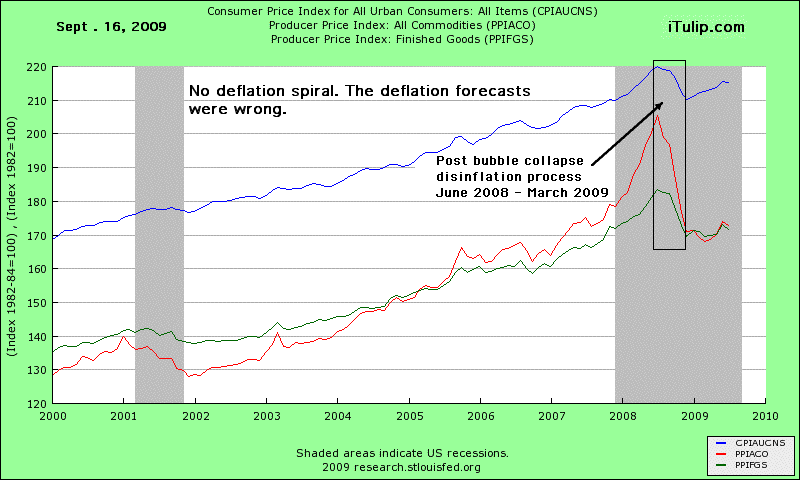
ND: So you were right about deflation. But where’s the inflation? Summarize your inflation forecast for us.
EJ: The primary source of inflation we forecast last year will result from currency depreciation. After a nine-month to one-year lag, we are seeing cost-push inflation from rising energy costs, especially oil. The second key source is supply destruction caused by industry consolidation through mergers and bankruptcies. The surviving firms will have enough pricing power to pass on the higher input costs that the Fed created when it put a floor on commodity prices with its anti-asset price deflation policies. The third source is the money supply itself, which after a lag will begin to feed into prices by Q1 2010 at the latest. There are others, but those are the main ones.
ND: In Everyone is wrong, again – 1981 in Reverse Part I: The Great Divide you said you thought investors buying 10-year Treasury bonds that earn 4.5% today are just as wrong about long-term future inflation as investors in 1980 who did not want to buy 10-year Treasury bonds that earned 15%, but for the opposite reason. In 1980 they were underestimating the willingness of authorities to stop inflation. Today they are over-estimating the authorities’ ability to tame inflation in the future. Do I have that right?
EJ: Bond markets have a poor record for forecasting future inflation at major geopolitical turning points. The last time this happened OPEC clouded the picture. This time domestic debt deflation and dubious economic reporting from China, our largest trade partner, and creditor are throwing everyone off.
We have a chart we update regularly called the Everyone is Wrong Again chart.
EJ: The primary source of inflation we forecast last year will result from currency depreciation. After a nine-month to one-year lag, we are seeing cost-push inflation from rising energy costs, especially oil. The second key source is supply destruction caused by industry consolidation through mergers and bankruptcies. The surviving firms will have enough pricing power to pass on the higher input costs that the Fed created when it put a floor on commodity prices with its anti-asset price deflation policies. The third source is the money supply itself, which after a lag will begin to feed into prices by Q1 2010 at the latest. There are others, but those are the main ones.
ND: In Everyone is wrong, again – 1981 in Reverse Part I: The Great Divide you said you thought investors buying 10-year Treasury bonds that earn 4.5% today are just as wrong about long-term future inflation as investors in 1980 who did not want to buy 10-year Treasury bonds that earned 15%, but for the opposite reason. In 1980 they were underestimating the willingness of authorities to stop inflation. Today they are over-estimating the authorities’ ability to tame inflation in the future. Do I have that right?
EJ: Bond markets have a poor record for forecasting future inflation at major geopolitical turning points. The last time this happened OPEC clouded the picture. This time domestic debt deflation and dubious economic reporting from China, our largest trade partner, and creditor are throwing everyone off.
We have a chart we update regularly called the Everyone is Wrong Again chart.
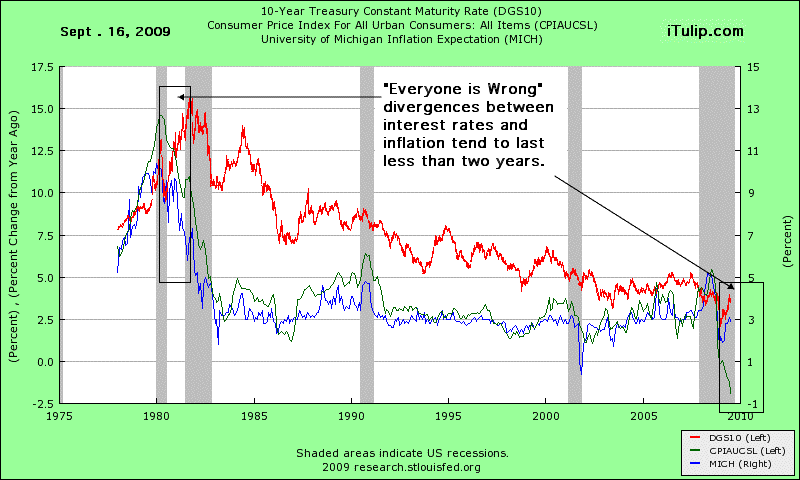
The long-term correlation between inflation expectations and CPI one year later has been strong since the University of Michigan began the survey in the 1970s. Yields on 10-year Treasury bonds also track well—except at major turning points in monetary and trade policy that impact the dollar such as in the early 1980s and today.
In 1980, a decade of inflation caused a general loss of confidence among foreign and domestic investors in the institutions that were capable of executing the necessarily politically painful changes needed to bring inflation under control. Today we have the different problem. Today investors believe that central banks are capable of executing on any plan they lay out before us. It’s odd because Paul Volcker himself said as recently as a few months ago, before the administration shut him up, that he could never execute today the kinds of policies that the Fed followed under his leadership, because the U.S. is a net debtor. Like Argentina, the U.S. no longer decides its economic policies independently. We gave that up when we took on all of the foreign debt. Every decision needs approval from foreign governments and institutions.
ND: Foreign lenders approve of inflationary policy?
EJ: They tolerate it with complaints. Policy is inflationary because in the short term nominal growth is better than no growth, and we need to attract capital. No growth is not an option; that's death for a net debtor. Now we're being asked by our creditors to raise taxes and cut our deficits, as if we were Argentina owing money to the IMF, because it looks like the slow growth will drag on. One thing leads to another.
ND: How do you see inflation in that graph above? It shows CPI inflation diving.
EJ: Yes, and you also see both 10-Year bond yields and inflation expectations rising. Not since the 1980s have we seen this kind of divergence, with inflation expectations and bond yields going in one direction and inflation in the other. There are two possible outcomes. Either bond yields and inflation expectations are wrong and reverse, or inflation will soon turn around and catch up with bond yields and inflation expectations. We’re betting on the latter. So are the commodity markets.
ND: Where will we see inflation show up first?
EJ: It already has, all around us in its all its nefarious forms. Most people thought that when the inflation started this year—the inflation that we forecast last year to start in the second half of this year—it would arrive with fanfare, with interest rates spiking up and double digit increases in food prices. Interest rates are rising gradually, as are some producer prices, but nothing dramatic. So far it's a slow grinding away of purchasing power.
Inflation is the erosion of the purchasing power of income and savings. It can result from many causes. A decrease in supply of goods relative to demand or an increase in the supply of money relative to demand, to name two. This way of looking at inflation takes into account currency depreciation, productivity gains and losses, and the distribution of personal expenditures on domestic and imported goods and services. The inflation question is, What can your income and savings buy today compared to last year?
ND: What costs more?
EJ: Incomes have steadily deflated against energy since 2003. The average savings account, earning 2% or so over that period, has been losing purchasing power, too. Savings held as gold and silver has for more than eight years maintained domestic and international purchasing power better than savings in stocks, bonds, and CDs. It's a sad testimony to the mismanagement of our economy, but there it is for all to see.
ND: Why is the purchasing power of our currency falling?
EJ: It’s easy to over-think the issue. I’m a businessperson. I think of the U.S. in business terms, as a business enterprise USA, Inc. I think of the dollar as representing a common share of that corporation. Its value is ultimately determined by the decisions of management, our elected officials. If they conduct the business badly—dilute shares, make decisions that cause the company to be less competitive, take on too much debt, and so on—the value of a share inevitably declines.
ND: How fast? Do you see a dollar crash?
EJ: Mostly a currency declines slowly as a result of an accumulation of errors over decades. Policies that led to decisions that were politically expedient in the short term result in long term structural impediments to growth. Through the 1960s and 1970s, spending on the Vietnam War and Great Society programs, a wage price spiral enabled by contractual wage price adjustments, and a weak geopolitical position with oil producers caused imbalances to build up and become self-reinforcing. Eventually a radical structural reset was needed, the kind the Reagan administration pulled off. To make a long story short we borrowed trillions of dollars to do in the Soviet empire. A new set of imbalances developed. Now we are heading toward a new reset. The difference is that we called the shots last time. This time our creditors will call the shots. If we want to go it alone we have to be prepared to see the dollar crash.
ND: What are the chances of that occurring?
EJ: There will be a reset. You can count on that. Our external debt will not double every five years ad infinitum to paper over our structural deficiencies. The ticking time bomb of foreign debt will run down sooner or later. The question is, Does a framework exist to defuse it? Is there time? I’m not as hopeful on this as I once was.
To begin with "management" needs to take on the politically difficult task of confronting the major source of our difficulties, inflated housing prices, the scene of the crime as it were. We spend three times more of our income every year on housing than we did 60 years ago. An automobile costs less of income but is 10 times better than 60 years ago. Food costs less, and our food supply is far safer than it was 60 years ago, despite what you might read. In fact, every other personal consumption expenditure—except for insurance and education—consumes either the same or less of our income than 60 years ago. Yet housing costs three times more. Has housing has improved as much as automobiles have over the same period? Of course not. They have been inflated by credit because mortgages were subsidized by government.
We need to undo the impact of decades of government subsidies of the housing industry. But I don’t see it happening. Where will the political will come from to do it when millions of home owners are complicit in the scheme? Who wants to see the price of their home fall 70%? But that’s what needs to happen to lower rents and mortgage payments enough to make U.S. labor competitive in the world. Housing costs are a major reason why a worker in India can live on $2,000 a year for the same job that pays $30,000 a year here that you can’t live on.
ND: What is the structural reset that needs to happen this time?
EJ: A reset to end U.S. dependence on global capital exports to finance trade and fiscal deficits.
Getting back to the dollar, as I was saying usually the decline is gradual due to the accumulation of structural imbalances over decades but there are times when a rapid currency decline happens that can be directly attributed to a single, massive management blunder.
For example, the 40% decline in the dollar between 2003 and 2008, after the start of the Iraq War. Beginning in 2003 we spent $1 trillion dollars to fight the war. We didn’t pay for the war out of savings and we didn’t raise taxes. We borrowed the money to pay for the war. Then we lost the war. Global currency markets started to discount the dollar from the start. Needless to say, losing an expensive war is not good for a nation’s currency, and any economist who thinks that a depreciating currency is deflationary should look back to the inflation data from 2003 to 2008, culminating in food riots in the Middle East and India. But the war was only one blunder by management during the period. Creating a housing bubble between 2002 and 2006 to pull the country out of the post stock market recession was another idiotic maneuver that weighs on the dollar.
ND: I see that you guys said in July 2008 to expect de-leveraging to go on for three to six months and for the dollar to stop rising and resume its decline after that.
EJ: We were close. The process took more like eight months. We didn’t fall into the trap of thinking the dollar had entered a secular bull market.
In 1980, a decade of inflation caused a general loss of confidence among foreign and domestic investors in the institutions that were capable of executing the necessarily politically painful changes needed to bring inflation under control. Today we have the different problem. Today investors believe that central banks are capable of executing on any plan they lay out before us. It’s odd because Paul Volcker himself said as recently as a few months ago, before the administration shut him up, that he could never execute today the kinds of policies that the Fed followed under his leadership, because the U.S. is a net debtor. Like Argentina, the U.S. no longer decides its economic policies independently. We gave that up when we took on all of the foreign debt. Every decision needs approval from foreign governments and institutions.
ND: Foreign lenders approve of inflationary policy?
EJ: They tolerate it with complaints. Policy is inflationary because in the short term nominal growth is better than no growth, and we need to attract capital. No growth is not an option; that's death for a net debtor. Now we're being asked by our creditors to raise taxes and cut our deficits, as if we were Argentina owing money to the IMF, because it looks like the slow growth will drag on. One thing leads to another.
ND: How do you see inflation in that graph above? It shows CPI inflation diving.
EJ: Yes, and you also see both 10-Year bond yields and inflation expectations rising. Not since the 1980s have we seen this kind of divergence, with inflation expectations and bond yields going in one direction and inflation in the other. There are two possible outcomes. Either bond yields and inflation expectations are wrong and reverse, or inflation will soon turn around and catch up with bond yields and inflation expectations. We’re betting on the latter. So are the commodity markets.
ND: Where will we see inflation show up first?
EJ: It already has, all around us in its all its nefarious forms. Most people thought that when the inflation started this year—the inflation that we forecast last year to start in the second half of this year—it would arrive with fanfare, with interest rates spiking up and double digit increases in food prices. Interest rates are rising gradually, as are some producer prices, but nothing dramatic. So far it's a slow grinding away of purchasing power.
Inflation is the erosion of the purchasing power of income and savings. It can result from many causes. A decrease in supply of goods relative to demand or an increase in the supply of money relative to demand, to name two. This way of looking at inflation takes into account currency depreciation, productivity gains and losses, and the distribution of personal expenditures on domestic and imported goods and services. The inflation question is, What can your income and savings buy today compared to last year?
ND: What costs more?
EJ: Incomes have steadily deflated against energy since 2003. The average savings account, earning 2% or so over that period, has been losing purchasing power, too. Savings held as gold and silver has for more than eight years maintained domestic and international purchasing power better than savings in stocks, bonds, and CDs. It's a sad testimony to the mismanagement of our economy, but there it is for all to see.
ND: Why is the purchasing power of our currency falling?
EJ: It’s easy to over-think the issue. I’m a businessperson. I think of the U.S. in business terms, as a business enterprise USA, Inc. I think of the dollar as representing a common share of that corporation. Its value is ultimately determined by the decisions of management, our elected officials. If they conduct the business badly—dilute shares, make decisions that cause the company to be less competitive, take on too much debt, and so on—the value of a share inevitably declines.
ND: How fast? Do you see a dollar crash?
EJ: Mostly a currency declines slowly as a result of an accumulation of errors over decades. Policies that led to decisions that were politically expedient in the short term result in long term structural impediments to growth. Through the 1960s and 1970s, spending on the Vietnam War and Great Society programs, a wage price spiral enabled by contractual wage price adjustments, and a weak geopolitical position with oil producers caused imbalances to build up and become self-reinforcing. Eventually a radical structural reset was needed, the kind the Reagan administration pulled off. To make a long story short we borrowed trillions of dollars to do in the Soviet empire. A new set of imbalances developed. Now we are heading toward a new reset. The difference is that we called the shots last time. This time our creditors will call the shots. If we want to go it alone we have to be prepared to see the dollar crash.
ND: What are the chances of that occurring?
EJ: There will be a reset. You can count on that. Our external debt will not double every five years ad infinitum to paper over our structural deficiencies. The ticking time bomb of foreign debt will run down sooner or later. The question is, Does a framework exist to defuse it? Is there time? I’m not as hopeful on this as I once was.
To begin with "management" needs to take on the politically difficult task of confronting the major source of our difficulties, inflated housing prices, the scene of the crime as it were. We spend three times more of our income every year on housing than we did 60 years ago. An automobile costs less of income but is 10 times better than 60 years ago. Food costs less, and our food supply is far safer than it was 60 years ago, despite what you might read. In fact, every other personal consumption expenditure—except for insurance and education—consumes either the same or less of our income than 60 years ago. Yet housing costs three times more. Has housing has improved as much as automobiles have over the same period? Of course not. They have been inflated by credit because mortgages were subsidized by government.
We need to undo the impact of decades of government subsidies of the housing industry. But I don’t see it happening. Where will the political will come from to do it when millions of home owners are complicit in the scheme? Who wants to see the price of their home fall 70%? But that’s what needs to happen to lower rents and mortgage payments enough to make U.S. labor competitive in the world. Housing costs are a major reason why a worker in India can live on $2,000 a year for the same job that pays $30,000 a year here that you can’t live on.
ND: What is the structural reset that needs to happen this time?
EJ: A reset to end U.S. dependence on global capital exports to finance trade and fiscal deficits.
Getting back to the dollar, as I was saying usually the decline is gradual due to the accumulation of structural imbalances over decades but there are times when a rapid currency decline happens that can be directly attributed to a single, massive management blunder.
For example, the 40% decline in the dollar between 2003 and 2008, after the start of the Iraq War. Beginning in 2003 we spent $1 trillion dollars to fight the war. We didn’t pay for the war out of savings and we didn’t raise taxes. We borrowed the money to pay for the war. Then we lost the war. Global currency markets started to discount the dollar from the start. Needless to say, losing an expensive war is not good for a nation’s currency, and any economist who thinks that a depreciating currency is deflationary should look back to the inflation data from 2003 to 2008, culminating in food riots in the Middle East and India. But the war was only one blunder by management during the period. Creating a housing bubble between 2002 and 2006 to pull the country out of the post stock market recession was another idiotic maneuver that weighs on the dollar.
ND: I see that you guys said in July 2008 to expect de-leveraging to go on for three to six months and for the dollar to stop rising and resume its decline after that.
EJ: We were close. The process took more like eight months. We didn’t fall into the trap of thinking the dollar had entered a secular bull market.
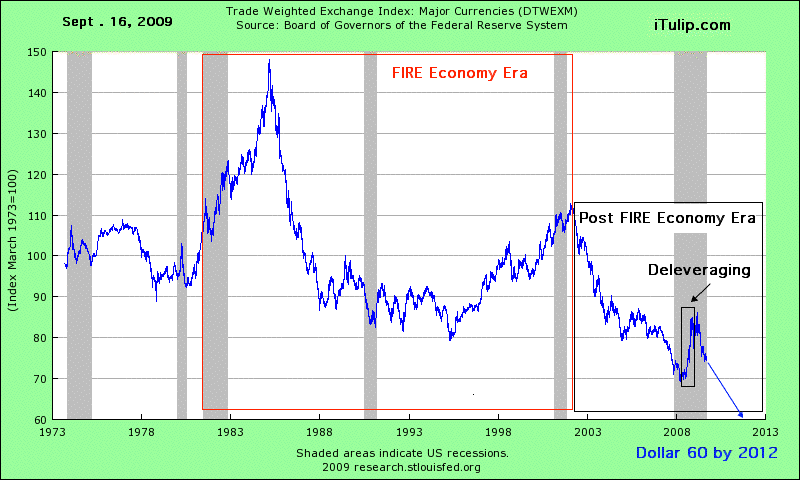
ND: Where do you see the dollar going from here?
EJ: We’re sticking with our dollar 60 by 2012 forecast that we made in March 2009.
ND: You don’t see the new administration correcting the policy mistakes that are hurting the dollar?
EJ: No, they are compounding them. In the short term they didn’t have much choice. If you inherit a corporation with the kinds of problems USA, Inc. had at the end of 2008, it’s like taking over a ship that’s been torpedoed. The first order of business is keeping it from sinking to the bottom of the sea. Measures required to keep it afloat in the short term made many problems worse in the long term. The biggest of them is the administration’s response to the collapsed housing bubble.
Here the difference between the management decision process in a corporation versus in a plutocracy becomes apparent and the analogy breaks down. If the USA were a corporation instead of a country, new management could evaluate the housing industry as a line of business, take a 50% haircut on assets and restructure the debt down to half and be done with it. One of the benefits would be a 50% reduction in rents and mortgage payments. This would act as a gigantic tax cut on the economy, freeing household income to be spent on other things and providing a huge boost to consumer spending. I believe this would outweigh the negative wealth effects.
You hear a lot of talk about tax cuts to stimulate the economy but no one talks about a debt cut, but a debt cut will free far more household and business cash flow then cutting taxes. That will never happen because the banks need the flow of mortgage payments to survive, and in case you hadn’t noticed the banks have political influence in Congress that they are not giving up. So the government subsidizes mortgages to try to re-inflate housing prices.
DN: Is it working?
EJ: How could it not work, at least in the short term? Throw enough money at anything and it will rise in price, if only for a while.
A friend in the mortgage business sent us a note that explains that under the new Home Affordability program Fannie Mae is buying up first and second loans at what he describes as, “extremely dangerous and unprecedented levels.” Once owned by Fannie, principal reductions of $200,000 or more are being provided to borrowers. He adds, “Surely, a $200,000 principal reduction makes the $600 stimulus checks look like peanuts.” So after throwing trillions at the housing market to buy bad assets of lenders, back new mortgages through nationalized GSEs to absorb default risk that the private markets will not touch, and discount mortgages for new home purchases, we get an echo bubble that will last until either of two things happen, either employment rebounds so that more home owners can pay their mortgages or the U.S. government runs out of credit and can’t continue financing the housing market.
DN: You are not in the camp that says the U.S. housing market has turned around?
EJ: No. Later we’ll get into the data on the economy and housing that we use to back up this argument, but it comes down to trends in foreclosures, mortgage defaults, unemployment, and incomes. They are still headed in the wrong direction. For example, foreclosures are rising in every state in the country.
EJ: We’re sticking with our dollar 60 by 2012 forecast that we made in March 2009.
ND: You don’t see the new administration correcting the policy mistakes that are hurting the dollar?
EJ: No, they are compounding them. In the short term they didn’t have much choice. If you inherit a corporation with the kinds of problems USA, Inc. had at the end of 2008, it’s like taking over a ship that’s been torpedoed. The first order of business is keeping it from sinking to the bottom of the sea. Measures required to keep it afloat in the short term made many problems worse in the long term. The biggest of them is the administration’s response to the collapsed housing bubble.
Here the difference between the management decision process in a corporation versus in a plutocracy becomes apparent and the analogy breaks down. If the USA were a corporation instead of a country, new management could evaluate the housing industry as a line of business, take a 50% haircut on assets and restructure the debt down to half and be done with it. One of the benefits would be a 50% reduction in rents and mortgage payments. This would act as a gigantic tax cut on the economy, freeing household income to be spent on other things and providing a huge boost to consumer spending. I believe this would outweigh the negative wealth effects.
You hear a lot of talk about tax cuts to stimulate the economy but no one talks about a debt cut, but a debt cut will free far more household and business cash flow then cutting taxes. That will never happen because the banks need the flow of mortgage payments to survive, and in case you hadn’t noticed the banks have political influence in Congress that they are not giving up. So the government subsidizes mortgages to try to re-inflate housing prices.
DN: Is it working?
EJ: How could it not work, at least in the short term? Throw enough money at anything and it will rise in price, if only for a while.
A friend in the mortgage business sent us a note that explains that under the new Home Affordability program Fannie Mae is buying up first and second loans at what he describes as, “extremely dangerous and unprecedented levels.” Once owned by Fannie, principal reductions of $200,000 or more are being provided to borrowers. He adds, “Surely, a $200,000 principal reduction makes the $600 stimulus checks look like peanuts.” So after throwing trillions at the housing market to buy bad assets of lenders, back new mortgages through nationalized GSEs to absorb default risk that the private markets will not touch, and discount mortgages for new home purchases, we get an echo bubble that will last until either of two things happen, either employment rebounds so that more home owners can pay their mortgages or the U.S. government runs out of credit and can’t continue financing the housing market.
DN: You are not in the camp that says the U.S. housing market has turned around?
EJ: No. Later we’ll get into the data on the economy and housing that we use to back up this argument, but it comes down to trends in foreclosures, mortgage defaults, unemployment, and incomes. They are still headed in the wrong direction. For example, foreclosures are rising in every state in the country.
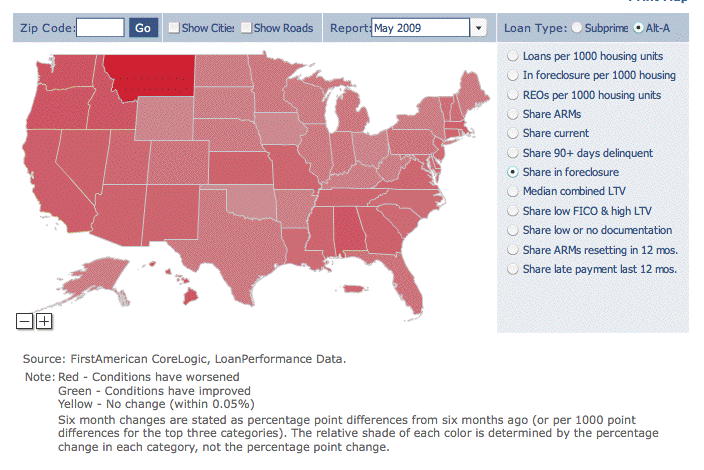
If the rate of foreclosures merely stabilized anywhere in the U.S. we’d see a spot of yellow or two on the graph above created with the Fed’s online dynamic housing conditions tools. Any shade of red indicates that conditions have worsened. This is not surprising given that unemployment has been rising in every state in the nation since January 2009.
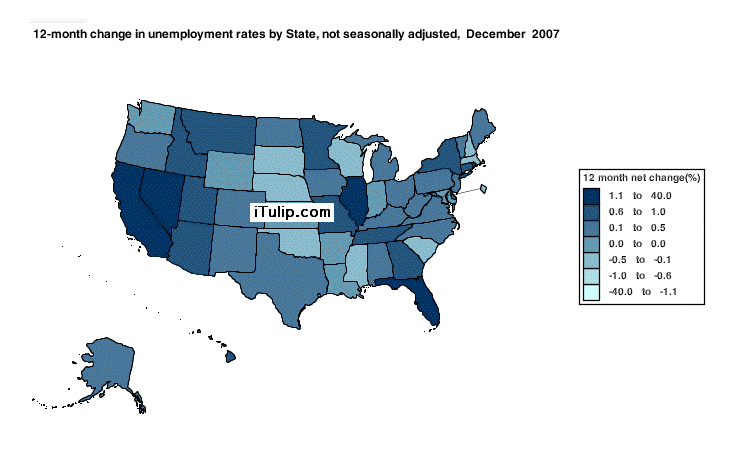
Dynamic map of year over year change in unemployment December 2007 to August 2009
Light blue = falling unemployment. Dark blue = rising unemployment.
Then there are the mortgages. Take California, the world’s seventh largest nation by GDP.

Dynamic map of year over year change in unemployment December 2007 to August 2009
Light blue = falling unemployment. Dark blue = rising unemployment.
Then there are the mortgages. Take California, the world’s seventh largest nation by GDP.
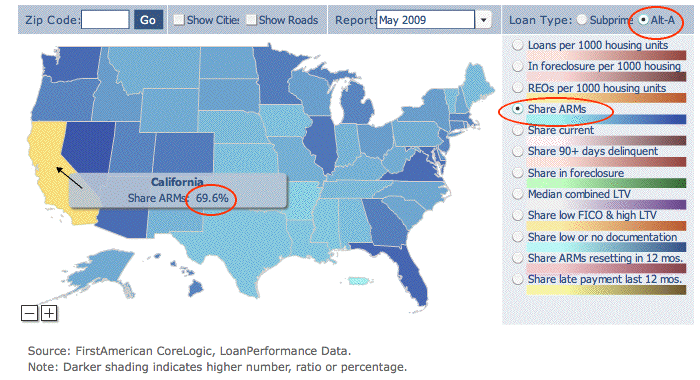
Just under 70% of ARMS in California are Alt-A, so-called prime not sub-prime mortgages.
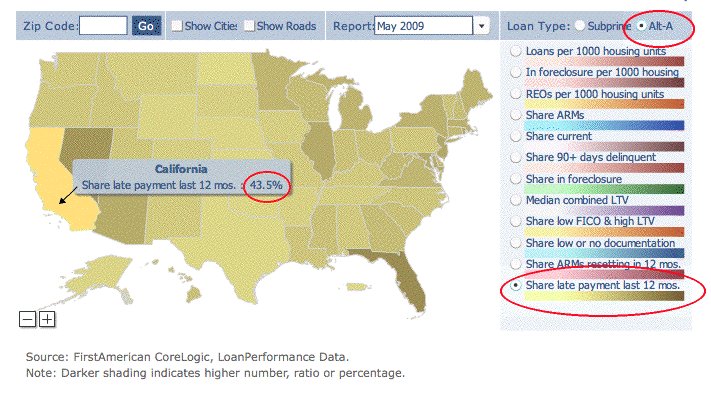
As of May, 44% of those mortgages were technically in default, of 70% of all ARMS; about 30% of all ARMS are in default.
Meanwhile, unemployment continues to rise.
Meanwhile, unemployment continues to rise.
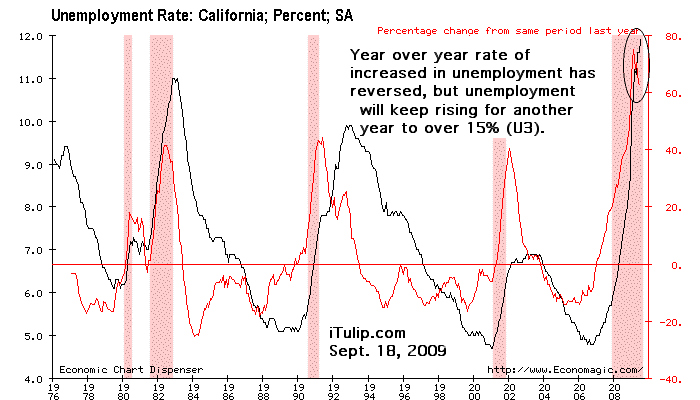
The heroic effort to rescue the housing market has produced a blip in the housing bubble reversion to the mean that we forecast in 2007.
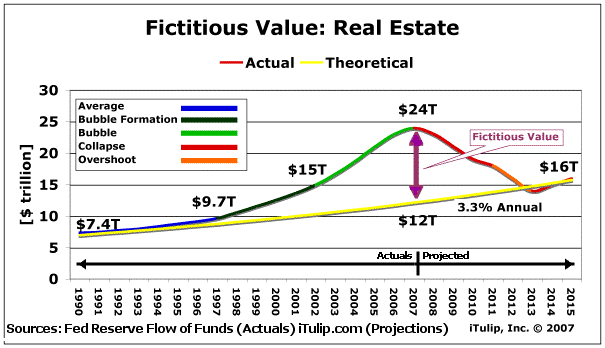
iTulip housing price forecast from 2007

Actual home prices as of July 2009
We tracked housing permit issuance to forecast the end of the housing bubble in 2005, so we return to it to help guide our forecast from here.
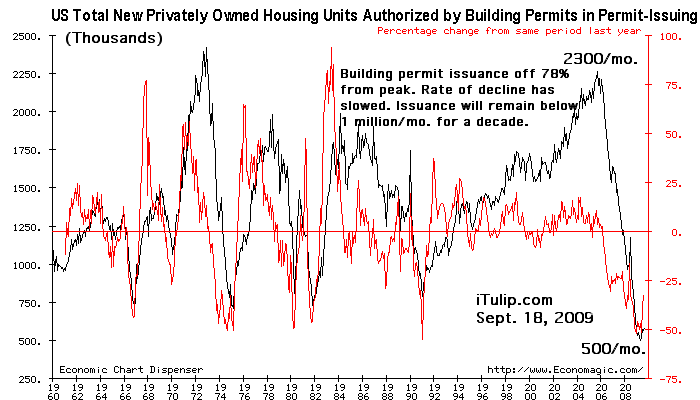
Building permit issuance has stopped declining year over year after falling 78% from the peak and may have stabilized. However, permit issuance will remain at early 1990s levels for the next decade.
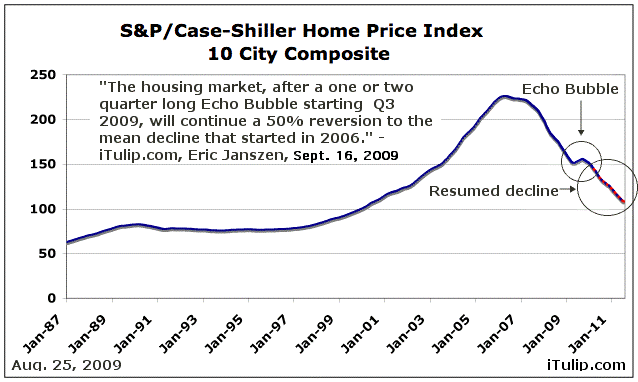
The housing echo bubble will not last long without sustained government support or a robust improvement in jobs and incomes. We expect the reversion to the mean process to continue next year.
ND: Robert Shiller says the housing bubble can be restarted.
EJ: How? The housing bubble was financed with private credit issued by investment banks, purchased by foreign investors, and sold by unaccountable lenders, with an entire chain of craziness, from bent appraisers and real estate lawyers to over-zealous commercial banks. The entire system has broken down. It can’t even function normally, never mind in hyper-drive to create a new bubble. Look at the rate of increase of loan losses for all sizes of banks.
ND: Robert Shiller says the housing bubble can be restarted.
EJ: How? The housing bubble was financed with private credit issued by investment banks, purchased by foreign investors, and sold by unaccountable lenders, with an entire chain of craziness, from bent appraisers and real estate lawyers to over-zealous commercial banks. The entire system has broken down. It can’t even function normally, never mind in hyper-drive to create a new bubble. Look at the rate of increase of loan losses for all sizes of banks.
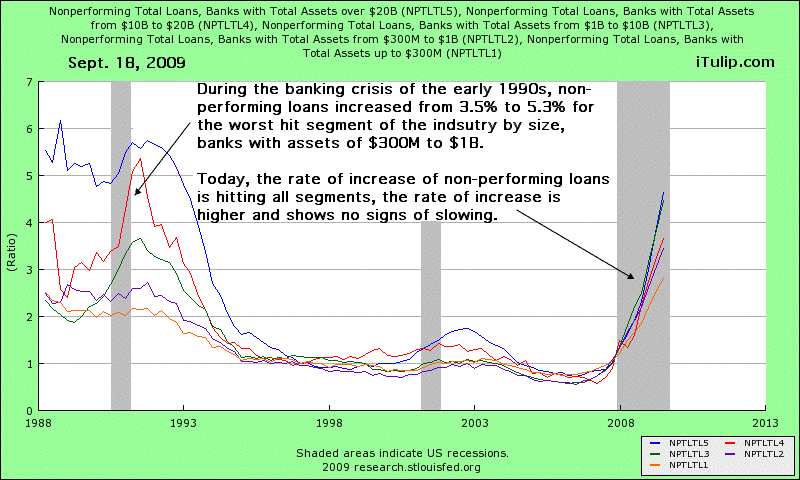
ND: That is one ugly chart.
EJ: Again, we have to keep this all in context. If we told readers in 2005 when we warned about the housing bubble that GSEs Fannie Mae and Freddie Mac were to be nationalized within three years, we’d have been called alarmist. But the Wall Street Journal reported on Tuesday that this year 80% of all mortgages were purchased in the secondary market by the FHA, versus 20% in 2006. What the chart above says to me is that some day down the road we may find a large segment of our banking industry has been nationalized much as we have for all intents and purposes nationalized the mortgage banking industry.
Think about what the virtual nationalization of mortgage debt means. It means that 80% of home sales that are occurring today would not occur except for the government’s guarantee of mortgage credit. We have for all intents and purposes a nationalized housing market here in the U.S. And who is backing the mortgage debt? Not investors in mortgage-backed securities in Europe and Asia. In fact, the Treasury is busy buying back Agency debt from them, the bonds issued by the GSEs, with Treasury bonds. You can see the net decline in purchases in agency debt and the corresponding rise in net purchases of Treasury bonds in the data.
ND: We’ve effectively nationalized our housing market?
EJ: Yes.
ND: How do we re-privatize it?
EJ: In my opinion, and this goes back to analysis I did in 2005, by inflating the nominal incomes of mortgage payers. Politically, I don’t see any other way.
ND: If the housing market resumes its decline, what happens to the recovery?
EJ: The housing bubble was financed with mortgages backed by securities sold to private and public investors all over the world. But these new mortgages are financed by the government. Each and every mortgage adds to our public debt. The administration’s approach to the private credit crisis is to create a future soveriegn credit crisis.
EJ: Again, we have to keep this all in context. If we told readers in 2005 when we warned about the housing bubble that GSEs Fannie Mae and Freddie Mac were to be nationalized within three years, we’d have been called alarmist. But the Wall Street Journal reported on Tuesday that this year 80% of all mortgages were purchased in the secondary market by the FHA, versus 20% in 2006. What the chart above says to me is that some day down the road we may find a large segment of our banking industry has been nationalized much as we have for all intents and purposes nationalized the mortgage banking industry.
Think about what the virtual nationalization of mortgage debt means. It means that 80% of home sales that are occurring today would not occur except for the government’s guarantee of mortgage credit. We have for all intents and purposes a nationalized housing market here in the U.S. And who is backing the mortgage debt? Not investors in mortgage-backed securities in Europe and Asia. In fact, the Treasury is busy buying back Agency debt from them, the bonds issued by the GSEs, with Treasury bonds. You can see the net decline in purchases in agency debt and the corresponding rise in net purchases of Treasury bonds in the data.
ND: We’ve effectively nationalized our housing market?
EJ: Yes.
ND: How do we re-privatize it?
EJ: In my opinion, and this goes back to analysis I did in 2005, by inflating the nominal incomes of mortgage payers. Politically, I don’t see any other way.
ND: If the housing market resumes its decline, what happens to the recovery?
EJ: The housing bubble was financed with mortgages backed by securities sold to private and public investors all over the world. But these new mortgages are financed by the government. Each and every mortgage adds to our public debt. The administration’s approach to the private credit crisis is to create a future soveriegn credit crisis.
 |
• Nationalized economy not resuscitating the consumer
• Ongoing declines in consumer debt and income do not point to a V-shaped recovery
• Wage rates among the employed are rising steeply
• Inflation will rise across the board in Q1 2010
ND: What’s with the stock market? In March you called this the “First Bounce of the Debt Deflation Bear Market” and in June said it was over, but after a dip it kept going up.
EJ: The First Bounce marked a new phase of post-FIRE Economy-based asset pricing and the start of re-inflation policy based asset pricing. The initial 30% plus gain off March panic lows represented a relief rally. Since then, many factors have combined to drive the market up, among them: funds playing the re-inflation trade, conservative long-short funds piling in to catch up to more aggressive funds that got back into the market in March, and retail investors chasing the recovery to name three.
ND: You have two apparently contradictory stock market forecasts. Late last year you said that in the second year of the Debt Deflation Bear Market the DJIA will rally to around 10,000 then end the year around 8,500. Then in August 2009 you said you thought the S&P will fall to 500 to 600 at some point before the end of the year. Here it is mid September and the DJIA is only a couple of hundred points shy of 10,000 and the S&P over 1060 is nowhere near 600. Do you still see the DJIA falling back to 8,500 and the S&P falling 40% to 600 over the next two and a half months?
EJ: The DJIA traded down to 6,500 in March then reached 8,800 at the time I said the first bounce was over, a 26% gain. Since then it’s up another 10%. So clearly it was not over. But here's why I'm not buying the rally.
The U.S. stock market is no more a market than the U.S. housing market is a market. There’s just too much printed money floating around to forecast it they way are used to starting in 1999, as a private capital bubble market. Remember that the value-based stock market ended in 1996 and the asset price inflation market driven by private capital began. We started to cover that here in 1998. The private capital bubble market ended in 2008 and the government reflation market began in 2009.
Our 2009 Debt Deflation Bear Market year two forecast used the first year of the government reflation market in Japan as a guide to the processes involved. The theory was that markets can’t tell the difference between government financed economic growth and organic economic growth.
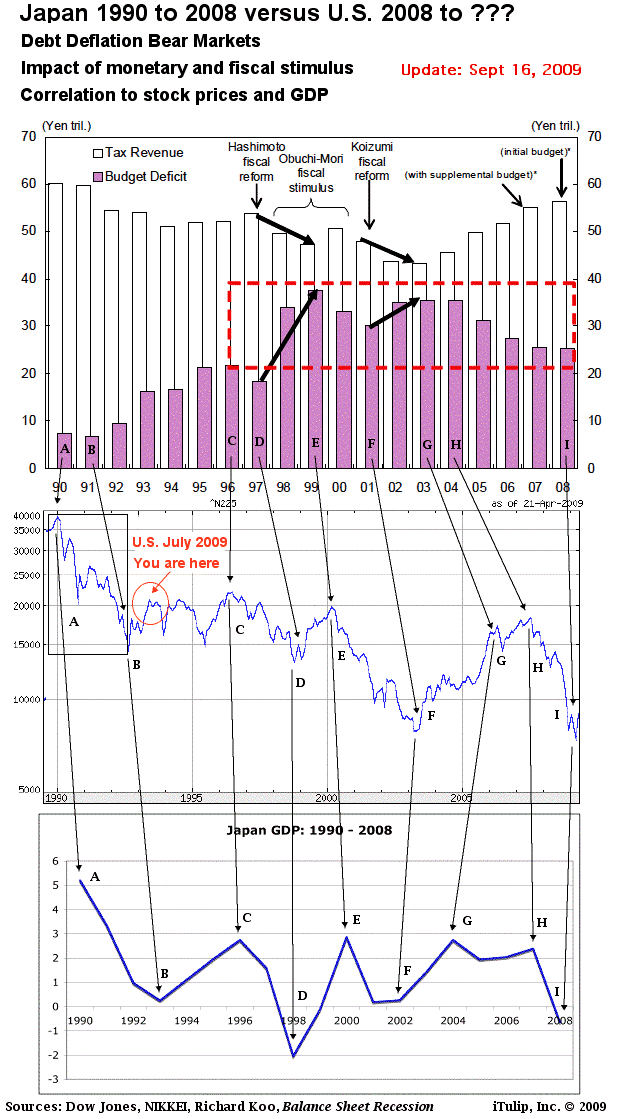
Chart correlates stimulus to GDP and stock prices
In December 2008, we applied this theory to the U.S. and estimate at the impact of fiscal spending in the second year of the Debt Deflation Bear Market.
In December 2008, we applied this theory to the U.S. and estimate at the impact of fiscal spending in the second year of the Debt Deflation Bear Market.
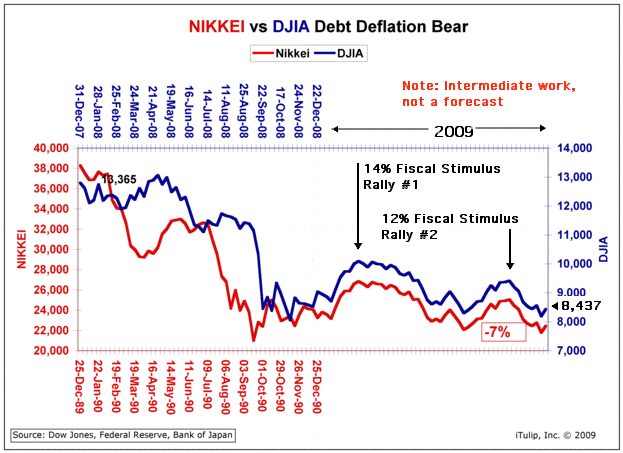
We show two rallies in 2009 resulting from the stimulus, the first takes the DJIA to 10,000 and the second to 9500.
This forecast is highly speculative because there is no way of knowing how the effect of the stimulus will express itself in stock prices, but I believe the principle is correct, just as the principle of debt deflation enabled us to accurately forecast the 40% decline in stock prices in 2008. But instead of two rallies we got one big one. We should have known.
If we have learned anything over the past ten years it’s this: Wall Street is very adept at taking a trend and turning into a bonus-packed juggernaut.
Take the commodity bull market in 2008, and especially oil. The weak dollar trend took oil from $16 to around $60. Wall Street then took it from $60 to $147. That game got cut off when capital inflows reversed. The liquidity drain crashed the securitized mortgage debt market in Q1 2007. The rest is history. more... ($ubscription)
iTulip Select: The Investment Thesis for the Next Cycle™
__________________________________________________
To receive the iTulip Newsletter or iTulip Alerts, Join our FREE Email Mailing List
Copyright © iTulip, Inc. 1998 - 2009 All Rights Reserved
All information provided "as is" for informational purposes only, not intended for trading purposes or advice. Nothing appearing on this website should be considered a recommendation to buy or to sell any security or related financial instrument. iTulip, Inc. is not liable for any informational errors, incompleteness, or delays, or for any actions taken in reliance on information contained herein. Full Disclaimer
This forecast is highly speculative because there is no way of knowing how the effect of the stimulus will express itself in stock prices, but I believe the principle is correct, just as the principle of debt deflation enabled us to accurately forecast the 40% decline in stock prices in 2008. But instead of two rallies we got one big one. We should have known.
If we have learned anything over the past ten years it’s this: Wall Street is very adept at taking a trend and turning into a bonus-packed juggernaut.
Take the commodity bull market in 2008, and especially oil. The weak dollar trend took oil from $16 to around $60. Wall Street then took it from $60 to $147. That game got cut off when capital inflows reversed. The liquidity drain crashed the securitized mortgage debt market in Q1 2007. The rest is history. more... ($ubscription)
iTulip Select: The Investment Thesis for the Next Cycle™
__________________________________________________
To receive the iTulip Newsletter or iTulip Alerts, Join our FREE Email Mailing List
Copyright © iTulip, Inc. 1998 - 2009 All Rights Reserved
All information provided "as is" for informational purposes only, not intended for trading purposes or advice. Nothing appearing on this website should be considered a recommendation to buy or to sell any security or related financial instrument. iTulip, Inc. is not liable for any informational errors, incompleteness, or delays, or for any actions taken in reliance on information contained herein. Full Disclaimer


Comment